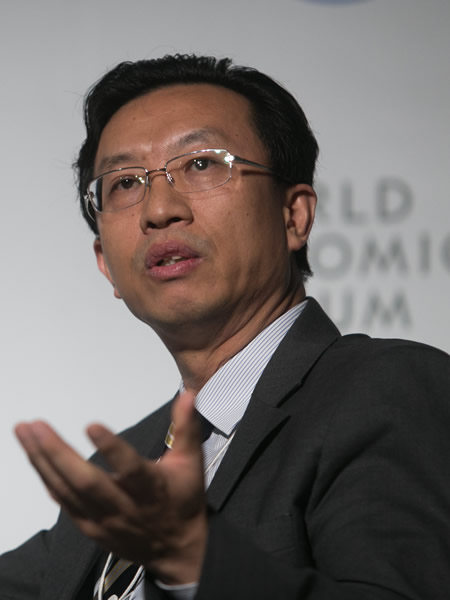« “Girls Speak Out” | Main | Diwali Greetings »
October 17, 2017
Singapore’s NTU and NUS top the latest QS Asia University Rankings released today, IIT Bombay top among Indian universities

Photo: Hongbo Chen, Vice-Dean, Tuspark Research Institute for Inovation, Tsinghua University, Beijing, China, during “Incubating Entrepreneurship” discussion at the World Economic Forum Meeting in Dalian, People’s Republic of China. Image provided by & copyright © World Economic Forum / Ciaran McCrickard.
The results of the QS Asia University Rankings are out now featuring 450 of the top universities in Asia. The ranking is based on a methodology which considers 10 performance indicators, including academic and employer reputation, the proportion of PhD qualified academic staff, and the proportion of inbound and outbound exchange students at the university.
QS ASIA UNIVERSITY RANKINGS 2018 — TOP 30
QS RANK — INSTITUTION — COUNTRY
- Nanyang Technological University (NTU), Singapore
- National University of Singapore (NUS), Singapore
- The Hong Kong University of Science and Technology, Hong Kong
- KAIST - Korea Advanced Institute of Science & Technology, South Korea
- The University of Hong Kong, Hong Kong
- Tsinghua University, China
- Fudan University, China
- City University of Hong Kong, Hong Kong
- Peking University, China
- The Chinese University of Hong Kong (CUHK), Hong Kong
- Seoul National University, South Korea
- Pohang University of Science And Technology (POSTECH), South Korea
- The University of Tokyo, Japan
- Tokyo Institute of Technology, Japan
- Osaka University, Japan
- Korea University, South Korea
- Kyoto University, Japan
- Sungkyunkwan University (SKKU), South Korea
- Yonsei University, South Korea
- Tohoku University, Japan
- Zhejiang University, China
- Shanghai Jiao Tong University, China
- University of Science and Technology of China, China
- Universiti Malaya (UM), Malaysia
- National Taiwan University (NTU), Taiwan
- Nanjing University, China
- Nagoya University, Japan
- The Hong Kong Polytechnic University, Hong Kong
- Kyushu University, Japan
- Hanyang University, South Korea
Indian Institute of Technology (IIT) Bombay emerged as the best Indian university. It was ranked 34th in Asia, followed by IIT Delhi (41), IIT Madras (48,) and Indian Institute of Science, Bengaluru (IISc) at 51. The 2018 rankings by QS showed that IISc, which was the best institution from India in 2016 and 2017, slipped the most among top Indian schools.
Traditional universities from India were led by University of Delhi (72), followed by Jadavpur University (125), University of Calcutta (125), Amrita University (168), University of Mumbai (181), Jamia Millia Islamia, New Delhi (200), Savitribai Phule Pune University (207), and Thapar University, Patiala (210).
QS ASIA UNIVERSITY RANKINGS 2018 — INDIA
QS RANK —Â INSTITUTION
- 34 Indian Institute of Technology Bombay (IITB)
- 41 Indian Institute of Technology Delhi (IITD)
- 48 Indian Institute of Technology Madras (IITM)
- 51 Indian Institute of Science (IISc) Bangalore
- 59 Indian Institute of Technology Kanpur (IITK)
- 62 Indian Institute of Technology Kharagpur (IIT-KGP)
- 72 University of Delhi
- 93 Indian Institute of Technology Roorkee (IITR)
- 98 Indian Institute of Technology Guwahati (IITG)
- 125 Jadavpur University
- 125 University of Calcutta
- 168 Amrita Vishwa Vidyapeetham (Amrita University)
- 181 University of Mumbai
- 187 Birla Institute of Technology and Science, Pilani
- 196 Indian Institute of Technology, Hyderabad
- 198 Manipal Academy of Higher Education
- 200 Jamia Millia Islamia, New Delhi
- 207 Savitribai Phule Pune University
- 210 Thapar University, Patiala
- 216 Amity University
- 223 Sri Venkateswara University
- 225 Banaras Hindu University
- 226 Indian Institute of Information Technology (IIIT) - Allahabad
- 228 National Institute of Technology Tiruchirappalli
- 238 Aligarh Muslim University (AMU), Aligarh
- 245 Bangalore University, Bangalore
- 247 Symbiosis International University
- 247 Tezpur University
- 271-280 VIT University
- 301-350 Andhra University
- 301-350 Panjab University (PU), Chandigarh
- 301-350 Anna University
- 301-350 Pondicherry University
- 351-400 Shanmugha Arts Science Technology and Research Academy (SASTRA)
- 351-400 SRM University
National University of Sciences And Technology, Islamabad (91) emerged as Pakistan’s highest ranked institution in QS Asia 2018 rankings. It was followed by Lahore University of Management Sciences (103), Pakistan Institute of Engineering and Applied Sciences (128), Quaid-i-Azam University (133), COMSATS Institute of Information Technology (190), University of Karachi (193), University of Engineering & Technology Lahore (200), University of the Punjab (PU), Lahore (232), and Aga Khan University (234).
QS ASIA UNIVERSITY RANKINGS 2018 — PAKISTAN
QS RANK —Â INSTITUTION
- 91 National University of Sciences And Technology (NUST) Islamabad
- 103 Lahore University of Management Sciences (LUMS)
- 128 Pakistan Institute of Engineering and Applied Sciences (PIEAS)
- 133 Quaid-i-Azam University
- 190 COMSATS Institute of Information Technology Pakistan
- 193 University of Karachi
- 200 University of Engineering & Technology (UET) Lahore
- 232 University of the Punjab (PU), Lahore
- 234 Aga Khan University
- 271-280 Institute of Space Technology
- 291-300 University of Agriculture, Faisalabad
- 301-350 The University of Lahore
- 301-350 University of Veterinary and Animal Sciences, Lahore
- 351-400 GC University Lahore
- 351-400 Mehran University of Engineering & Technology
Methodology
QS uses a unique methodology to calculate this ranking. The methodology is designed to account for the unique challenges facing the region’s universities, and features 10 indicators. They are:
- Academic Reputation (measuring research quality)
- Employer Reputation (measuring employability)
- Faculty/Student Ratio (measuring teaching quality)
- Papers per Faculty (research)
- Citations per paper (research)
- International Faculty Ratio (measuring internationalization)
- Staff with PhD (teaching quality)
- International Student Ratio (internationalization)
- Inbound Exchange Students (internationalization)
- Outbound Exchange Students (internationalization).
Ben Sowter, Research Director, QS, said: “This year’s rankings suggest that, in a number of nations, established hierarchies are being disrupted. This is a result of the region’s many universities continually striving to become competitive, forward-thinking, and internationally attractive.”
|GlobalGiants.Com|







Edited & Posted by the Editor | 4:40 AM | Link to this Post







